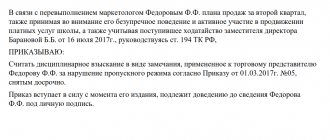- Types of disciplinary sanctions Reprimand as a disciplinary sanction
- Remark as a disciplinary sanction
- Dismissal as a disciplinary sanction
If facts of violation of labor discipline are established, disciplinary action can be applied to any employee of the organization. This possibility is established by various regulations governing labor legislation, including the Labor Code, disciplinary statutes (for example, “On the Armed Forces of Russia”), laws (for example, “On Civil Servants”) and other documents. The decision on disciplinary liability is made by the head of the enterprise or another person entrusted with this responsibility. What a disciplinary sanction is, how it is imposed and lifted, what types of liability are commensurate with a specific offense, and other similar issues will be discussed in this article.
Types of disciplinary sanctions
Article 192 of the Labor Code of the Russian Federation defines only 3 types of legal penalties that can be used:
- rebuke;
- comment;
- dismissal.
Often in the practice of various enterprises, cases arise when managers use a severe reprimand, deprivation of bonuses, transfer to a position with a reduced salary, warnings, fines, etc. for disciplinary action. All these measures cannot be considered legal. The only exceptions are cases when additional penalties are provided for by local laws or charters.
For example, in relation to military personnel, in addition to the standard ones, the following recovery options can be applied:
- reduction in rank by one or more steps;
- severe reprimand;
- disciplinary arrest;
- deprivation of a badge or another dismissal;
- early dismissal;
- expulsion from an educational institution or from military training;
- assignment of work order, etc.
Also, additional measures may be provided for by internal regulations and collective agreements. Only at the time of hiring the employee should be familiarized with the entire list of offenses for which liability may follow.
For each misconduct, an employee can be subject to no more than one type of disciplinary action. For example, you cannot be reprimanded for absenteeism, and later fired for it.
Reprimand as a disciplinary sanction
A reprimand is a form of disciplinary action that is given orally. Before it can be applied, an explanation must be sought from the guilty employee indicating all the circumstances and the reasons for the misconduct. Even during employment, a citizen must be notified of all types of misconduct for which he may receive a reprimand from his superiors.
The reprimand indicates the place, time, date, as well as the reasons for applying this type of penalty. In this case, the reprimand note is not included in the work book. But if this employee is subsequently dismissed due to regular violations of labor discipline, then the employer has the right to list all episodes of reprimands in the dismissal order, and indicate the details of this order in the work book.
If all of the specified features of issuing a reprimand are not observed by the employer, the employee can challenge the penalty.
Remark as a disciplinary sanction
In essence, a reprimand, neither in terms of legal consequences nor in the form of imposition, differs from a reprimand. The only difference is in the wording: “remark” sounds somewhat softer than a reprimand.
Dismissal as a disciplinary sanction
Dismissal, as the most severe disciplinary measure, can be used by a manager against a negligent employee only on the following grounds:
- Repeated failure to fulfill job duties.
- The presence of cases where the employee was previously subjected to other, milder types of disciplinary liability.
- Refusal to perform or improper performance of labor duties without good reason. If a citizen cannot work normally due to lack of normal working conditions or insufficient qualifications, due to health reasons, his dismissal is not legal.
What types of disciplinary sanctions are established?
Art. 192 of the Labor Code of the Russian Federation contains a list of penalties:
- Comment. It is considered a mild form of punishment. It expresses censure of the employer and is imposed for minor deviations from the rules. The note is more of a warning nature.
- Rebuke. This measure is applied in cases where the offense falls into the category of serious violations of labor rules.
- Dismissal with reference to the relevant article of the Labor Code. The most severe type of punishment is resorted to if the employee has committed gross violations of official duties and discipline: appearing drunk, embezzlement of entrusted property, or has previously been subject to disciplinary action.
Penalties in the form of depreciation, demotion or fine are not considered disciplinary sanctions and are not subject to application.
The specifics of certain categories of employees may provide for other types of punishment. For example, deprivation of a badge and reduction in rank are applicable to military personnel. Prosecutor's officials may be subject to severe reprimands.
For one offense, an employee is subject to one type of liability. In this case, it is not necessary to follow the sequence set out in Article 192 of the Labor Code of the Russian Federation. The penalty depends on the severity of the specific offense and its consequences. To avoid conflicts with the employer, you, as an employee, must know everything about the contractual regulation of labor relations.
Misdemeanors - grounds for disciplinary action
Disciplinary action is used only in case of labor misconduct, namely: for failure to perform or poor performance of duties by an employee due to his personal fault. The entire list of labor offenses is contained in Article 81 of the Labor Code of the Russian Federation, indicating the type of liability corresponding to a particular offense. This is why the employer has every right to bring the employee to a certain type of disciplinary liability:
- One-time gross violation of labor discipline. Examples: theft, drunkenness at work, absenteeism, disclosure of trade secrets, etc. If any of the listed facts are discovered, the employer has the right to apply at its discretion any type of disciplinary action (maximum - dismissal).
- Guilty actions of persons who are financially responsible. Here we are talking only about employees whose employment contracts provide for the possibility of bringing them to financial liability (for example, sellers, cashiers or storekeepers). For material misconduct, they can be subject to dismissal, reprimand or reprimand.
- Providing false documents by a citizen when hiring. Dismissal is usually applied for this offense. However, if a false document on education was provided, which is not required to perform the assigned duties, then the dismissal of such an employee is illegal.
- Failure to perform labor functions without good reason. In this category, the offense of being late is quite common. An employee cannot be fired for being late once. First, it is necessary to issue a reprimand, if repeated, a reprimand, and only in case of systematic delays can a decision be made about dismissal.
Disciplinary sanctions for absenteeism
Absenteeism is a serious offense for which the manager can subject the employee to any type of disciplinary action, up to and including dismissal (even if it is a one-time occurrence). The most difficult thing in this matter is the interpretation of the concept of “truancy”. In Russian legislation, it is defined as the absence of an employee from the workplace without good reason for more than three hours during the working day. Absenteeism can be considered a failure to show up for work at all, or absence from work continuously for three hours or for the entire day in total. Example: an employee was one hour late, then left the workplace without permission for 1 hour 40 minutes and left half an hour earlier than expected; This day can be counted as absenteeism for him.
We are talking about the employee being at his specific work place - in the office, at the machine, etc. If he was not at the workplace for more than three hours, but was present on the territory of the enterprise, even if he did not perform his official duties, count this day The employer has no right to pay for absenteeism. This situation to a greater extent falls under the concept of violation of labor discipline, for which the employer can issue a reprimand or reprimand, but not fire.
Actions that can be qualified as truancy:
- Unauthorized use of days off or going on vacation without approval.
- Unauthorized replacement of shifts, with the exception of situations when it is performed within one day. In this situation, we are talking about violation of labor discipline, and not about absenteeism.
- Failure to show up for work to which the employee was legally transferred.
- Absence from work on a holiday or day off, provided that it is declared a working day. But engaging an employee to work without his consent on a non-working day is illegal.
- Leaving a place of work by a person after graduating from an educational institution when sending him to a given enterprise to work for a specific time. However, the failure of a young specialist to show up to an assigned employer cannot be considered absenteeism, since there is no labor relationship between them yet.
- Failure of a posted worker to appear at the enterprise to which he is assigned.
An employee’s absence from the workplace for valid reasons is not considered absenteeism, namely:
- disaster;
- disruptions in the operation of the transport system;
- illness of the employee himself or the need to care for a sick family member;
- passing the session without taking leave;
- absence from work with the permission of authorized managers of the enterprise, etc.
Contents of Art. 193 TK
At the beginning it says that the employer, even before imposing a penalty, must demand a written explanation from the subordinate who committed the violation. The subordinate is given two days to draw up this document. If an explanation has not been received within this period, then a corresponding act is drawn up.
It is separately emphasized that the absence of this explanation does not prevent the application of penalties.
The following describes restrictions on the period of use of penalties. The employer has a month to use it from the date the employee’s misconduct was discovered (the moment the manager learned about it). This period increases in the following cases:
- illness of the offending employee;
- his vacation;
- the need to take into account the opinion of the relevant body of personnel representatives.
In the next paragraph, the timing of the use of penalties is discussed in more detail. When an offense is committed, and not discovered, as mentioned earlier:
- by default, the period of application of penalties is limited to six months;
- the period is increased to two years if violations were discovered due to an appropriate audit or inspection;
- the period is three years in cases of corruption - this period does not include criminal proceedings.
It is separately emphasized that for each individual violation only one penalty is imposed - they should not be multiplied.
The employer's order for collection is presented to the employee against his signature. The period for this presentation is limited to three days from the date of issuance of the order, not counting the time the employee is absent from the workplace. If the employee does not want to get acquainted with this document, then a corresponding act is drawn up.
The conclusion states that the penalty received by the employee can be challenged by him in the labor inspectorate and/or relevant bodies for the analysis of labor disputes.
The chapter under consideration, as can be seen from its contents, prescribes in detail the order and mandatory points that the employer must take into account when deciding on the use of disciplinary sanctions in relation to offending employees. Otherwise, as confirmed by judicial practice, penalties may be declared untenable and will have to be cancelled.
Disciplinary responsibility of the manager
Bearing in mind that the decision to impose a disciplinary sanction is made by the head of the enterprise, a completely logical question arises - is it possible to hold the director of the organization accountable? Since the director, like any other employee of the enterprise, is obliged to comply with the rules established not only by legislative acts, but also by local documents (labor safety instructions, labor regulations within a legal entity, etc.). In addition, the manager must fulfill his functional responsibilities and implement the decisions of higher authorities. Therefore, in case of failure to comply with the requirements of labor discipline or negligent performance of official duties, the director may also be subject to disciplinary action.
This procedure can be initiated by the employees of the organization themselves through a representative body of employees (trade union committee) or the employer. The problem is that it is quite difficult to monitor how disciplined a manager is in fulfilling the requirements of labor discipline. The fact is that the specific nature of the work of most directors involves a traveling nature of the work. But it is quite simple to determine how well the director performs his functions by analyzing the accounting and statistical reporting of the organization.
For misconduct committed, the manager may be subject to standard types of disciplinary action - a reprimand, reprimand or dismissal. They are imposed by the owner of the organization or the employer.
Procedure for applying disciplinary sanctions
Disciplinary proceedings consist of the following stages:
- The employer gives the employee the opportunity to explain the reasons for his misconduct in writing. If this is refused, the person entrusted with such a duty (director, head of the personnel department or structural unit) draws up an act indicating the place and time of drawing up the document, the full names of the persons who drew up the act and committed the violation, the essence of the offense, the employee’s explanation for this fact or an indication to refuse to give explanations, etc.
- Obtaining from the head of the structural unit in which the offender is a member, evidence of the offense committed (for example, a time sheet indicating the hours of absence of the employee), as well as his opinion on what type of disciplinary sanction corresponds to the gravity of the act committed.
- The head of the organization makes a decision about the guilt of the employee. In doing so, he takes into account mitigating circumstances (if any).
- The director issues an order imposing a disciplinary sanction. A sample of it can be found below. The employee should be familiarized with the order within three working days from the date of its publication. If you refuse to sign the order, a corresponding act is drawn up.
sample order to impose a disciplinary sanction.docx
What are the rules for imposing disciplinary sanctions?
The procedure for bringing to disciplinary liability consists of the sequential implementation of the following actions:
Recording a violation
At this stage, it is necessary to document the employee’s misconduct by drawing up an act on the identification of the illegal act and submitting a report to management.
If the offense is committed by failing to report to work at the appointed time, the personnel officer or other person whose functions include monitoring the performance of official duties by employees prepares an appropriate act. It is advisable to involve two witnesses to this, who will certify with their signatures the validity of the failure to appear. In addition, personnel personnel make an appropriate note on the report card.
The management of the enterprise is notified about the incident, which, depending on the specific offense, orders an internal investigation.
Requesting an explanation from the perpetrator
The employer invites the employee to prove the valid reasons for the misconduct by sending him a written demand. If the employee does not mind providing an explanation, you can limit yourself to a verbal request.
An explanatory note is drawn up in any form and sent to the employer within two days. If necessary, supporting documentation is attached.
If the guilty person fails to provide the document within the specified period, the responsible person of the employer draws up an act of refusal to provide explanations.
Internal investigation
The Labor Code does not contain the term “internal investigation”, but in order to comprehensively and objectively consider the case, organizations practice conducting it.
For this purpose, by order of the employer, a special commission is formed, which includes representatives of the personnel service, security department and internal audit.
Members of the commission are engaged in collecting evidence, interviewing eyewitnesses, conducting examinations, in short, finding out all the circumstances and reasons for the commission of the offense.
The results of the consideration of the special commission are formalized in the form of a conclusion, which gives a legal assessment of what happened and recommendations on the type of disciplinary action against the employee.
If during the internal investigation it turns out that the employee’s actions show signs of a criminal act, the manager is asked to transfer the material to law enforcement agencies or the prosecutor’s office.
Terms of imposition and terms of application of disciplinary sanctions
The following terms are typical for disciplinary records: 1 month and six months. If one month has already passed after the commission of the labor offense, then the imposition of a penalty becomes impossible. The counted time does not include periods when the employee is on vacation or sick leave. The maximum period of time for which an employee must be brought to disciplinary liability is 6 months. This period can be extended to two years only if a comprehensive audit of financial and economic activities or an audit is carried out at the enterprise.
What is the time frame for disciplinary proceedings?
The timing of imposing a disciplinary sanction is regulated by Article 193 of the Labor Code. An employee can be punished if one month has not passed since the day when the direct supervisor of the guilty person became aware of the offense. This period does not include time spent on vacation and sick leave.
It is impossible to apply a penalty after six months from the date of commission of the illegal act. This period increases to two years if illegal actions are identified as a result of a financial audit or audit. It does not include time spent on criminal proceedings.
Removal of disciplinary action
If, within one year after the penalty is issued, the employee conscientiously fulfills his duties and is not brought to disciplinary action again, the penalty is automatically lifted, and the violator is considered to have no disciplinary action.
There are cases when responsibility is removed early. Most often this happens on the initiative of the head of the enterprise or at the request of the head of a structural unit or trade union committee. The violator himself can initiate the removal of the penalty by personally making such a request to the employer.
When an appropriate decision is made, an order to lift the disciplinary sanction must be drawn up. A sample of it can be viewed here.







